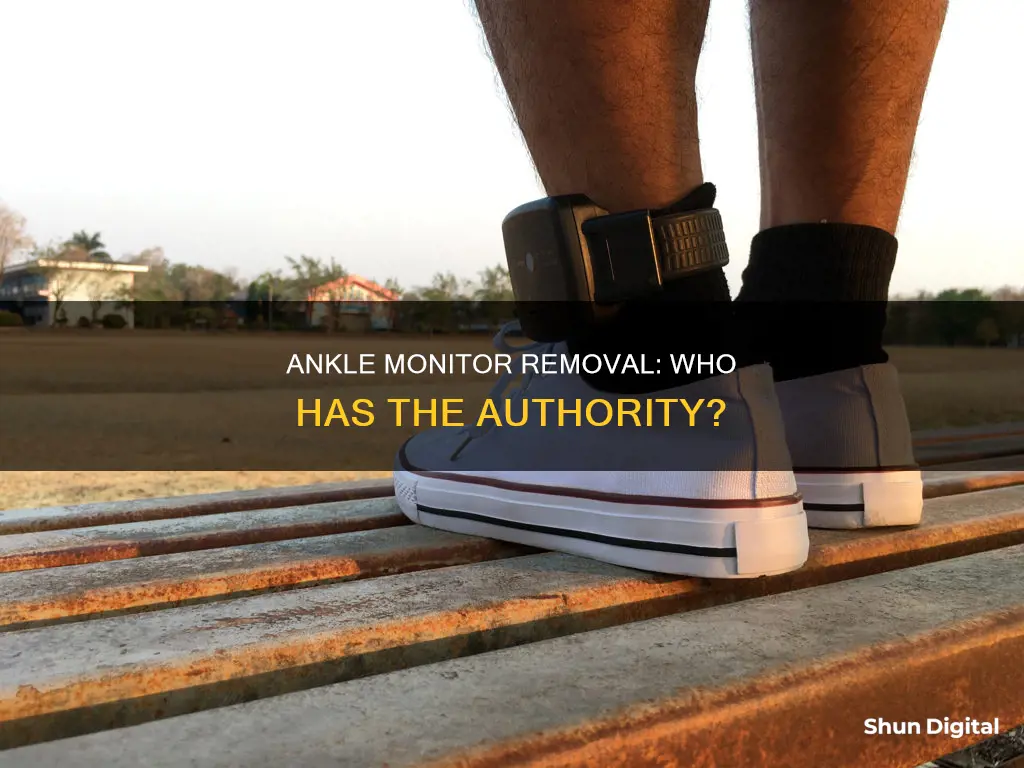
Ankle monitors are used to track a person's location or alcohol consumption, and they can significantly interfere with a person's life, work, and ability to travel. While ankle monitors are not designed to be impossible to remove, tampering with them is illegal and will have legal consequences. The proper way to have an ankle monitor removed is by submitting an official request or motion to the court, which a judge will rule on.
| Characteristics | Values |
|---|---|
| Types of ankle monitors | CAM (continuous alcohol monitor), GPS (global positioning system) |
| Purpose of ankle monitors | 24/7 monitoring of alcohol consumption or location |
| Ability to submerge in water | Not allowed to submerge in water, but can take showers |
| Sensitivity | CAM is very sensitive and can be triggered by spilled drinks or cleaning products containing alcohol |
| Legal removal | Submit an official request to the court, citing a legitimate reason |
| Illicit removal | Can be cut off with a pair of scissors, but will set off an alarm and be considered a violation of the monitoring program |
What You'll Learn

Legally removing an ankle monitor
Ankle monitors are used to ensure that the wearer does not consume alcohol or to monitor their location. While they are necessary in some cases, they can interfere with your life, ability to travel, and work.
- Have a legitimate reason for removing your ankle monitor. This could include job-related requirements, conflicts with work clothing, travel demands, underwater jobs, medical attention, severe ankle pain, mental stress, or any other valid reason that interferes with the ankle monitor.
- Communicate with your supervision officer and explain your reasons for wanting to remove the ankle monitor. It is important to maintain a positive relationship and respect their decision, even if they decide not to approve your request.
- Create a motion document with the help of an attorney to ensure it follows the correct rules, protocols, and professional terms. The motion should include the name of the court, the plaintiff or prosecutor, the defendant, and a clear title and body explaining your request and case background.
- Include a conclusion in your motion, restating your request to remove the ankle monitor, and provide a signature and date.
- Make multiple copies of your motion document and send it to your supervision officer and prosecutor. Keep a physical copy with you and send a copy to all relevant parties.
- Set up a hearing date by submitting a form known as a Notice of Hearing. Include the date, time, and location of the hearing.
- Submit your motion to the court by bringing the original document and copies. There may be a filing fee, and the court staff will review and approve your motion.
- Send a copy of your motion and the hearing schedule to your prosecutor and supervision officer. While this step is optional, it can increase the chances of your request being granted by showing respect and transparency.
- Attend the court hearing on time, dressed appropriately, and with all the required documents.
- State your argument clearly and precisely, introducing yourself and providing a strong opening statement.
- Receive the decision from the judge, who will consider all aspects of the case, including your charges, the suggestions of the prosecutor and supervision officer, and your reported behaviours.
It is important to note that removing an ankle monitor without following the legal process can have serious consequences. Cutting off or tampering with the device is not recommended and will be considered a violation of the monitoring program.
Additionally, there are two types of ankle monitors: CAM (continuous alcohol monitors) and GPS (global positioning systems). Depending on the circumstances of your case, you may be required to wear one or both types of ankle monitors.
Consulting with a legal attorney who can provide experienced insights and guide you through the process is highly beneficial. They can help you navigate the legal system, increase the chances of your request being granted, and ensure that your rights are protected.
Hooking Up Four Monitors: The Ultimate Guide
You may want to see also

Types of ankle monitors
There are three main types of ankle monitors: Radio Frequency (RF), Global Positioning System (GPS), and Secure Continuous Remote Alcohol Monitoring (SCRAM).
Radio Frequency (RF) ankle monitors are typically used to enforce curfews. They consist of a wearable monitoring device and a secondary home unit. The home unit detects the bracelet within a range of 50 to 150 feet and sends a notification to a monitoring centre. RF monitors are often used for house arrest, where the individual is supposed to remain at home at specific times.
Global Positioning System (GPS) ankle monitors track the wearer's location using GPS technology. They offer more freedom of movement compared to RF monitors, as they can be programmed with inclusion and exclusion zones. GPS monitors can be set to specific schedules, allowing individuals to travel to pre-approved locations. They are useful for restricting offenders from going near certain locations or people.
Secure Continuous Remote Alcohol Monitoring (SCRAM) ankle monitors are primarily used to detect alcohol consumption. They periodically test the wearer's sweat for alcohol content. SCRAM monitors are often used for individuals with alcohol-related offences, such as driving under the influence (DUI). They are designed to help enforce restrictions on alcohol consumption and can also track the wearer's location using GPS.
In addition to these three main types, there are also voice curfew systems, which do not require the wearer to have a physical device. Instead, the individual is required to have a phone line and receive scheduled calls from a voice curfew company. Voice detection technology is used to verify the person's identity, and they are subject to random calls as well.
Differentiating Monitor Resolutions: 480x720 vs 800x480
You may want to see also

Ankle monitor restrictions
Ankle monitors are used as a surveillance tool by law enforcement to monitor individuals on parole, probation, or house arrest. They are often used as an alternative to incarceration or traditional forms of pretrial release, allowing offenders to retain some freedom of movement while being monitored. There are two main types of ankle monitors: GPS monitors and continuous alcohol monitors (CAMs).
GPS Monitors
GPS ankle monitors track the wearer's location 24/7 and send this information to a monitoring station. They are often used to enforce exclusion zones or "house arrest." Exclusion zones are areas that the wearer is prohibited from entering, such as the home or workplace of an alleged victim in a criminal case. With house arrest, the wearer is typically restricted to their home county and only allowed to travel to and from work.
CAMs
CAMs, or continuous alcohol monitors, function like a breathalyzer attached to the ankle. They test the wearer's perspiration for alcohol every 30 minutes, providing round-the-clock supervision to ensure the wearer does not consume alcohol.
General Restrictions with Ankle Monitors
Ankle monitors can interfere with daily life, work, and travel. They are locked in place to prevent removal and have sensors that notify authorities if tampered with. Wearers are typically required to pay a daily fee for the device, which can range from $5 to $25 per day.
There are rules and conditions that must be followed when under electronic monitoring. These include:
- Curfew hours and restrictions on leaving home, except for authorized reasons such as work, education, medical appointments, or court appearances.
- Regular drug or alcohol testing, depending on the nature of the offense.
- Abstaining from alcohol, as even hand sanitizer, cologne, or cleaning products can trigger an alcohol consumption alert.
- Staying within a specific geographic region or perimeter.
- Meeting with probation or parole officers at scheduled times.
- Paying all court fees.
Consequences of Violation
If the conditions of the ankle monitor are violated, there can be serious consequences. This includes attempting to remove or damage the device, which will automatically send a signal to law enforcement. Submerging the device in water, for example, by going swimming, is also prohibited and will be flagged as an attempt to defeat the device.
Violation of the terms can result in arrest, stricter monitoring, parole revocation, and jail time. Additionally, the wearer may be charged with the crime of escape, which carries felony penalties.
Monitor SV: How to Easily Identify It
You may want to see also

Ankle monitor maintenance
Ankle monitors are an important tool in the criminal justice system, allowing individuals to remain out of custody while ensuring compliance with the terms of their release. These devices can track location and monitor specific behaviours, such as alcohol consumption. While they provide numerous benefits, ankle monitors can also interfere with daily life, impacting travel and work. Proper maintenance and care are crucial to ensure the device functions effectively and doesn't draw unwanted attention.
Clothing Choices:
Select clothing that covers the ankle monitor. Opt for long pants, skirts, or dresses that fall below the ankle. Loose-fitting and dark-coloured clothing can effectively conceal the device. If you prefer shorter attire, consider knee-high socks or leg warmers to cover the monitor discreetly. Ensure the chosen materials are comfortable and breathable to maintain comfort and avoid irritation.
Accessories:
Use accessories to divert attention away from the monitor. Anklets, bracelets, or even a small knee brace can draw attention to these items instead. However, always comply with the rules set by legal authorities, as this method may not always be advisable or permitted.
Care and Maintenance:
Keep the ankle monitor clean and free from visible damage or signs of wear. Regularly inspect and adjust the device to ensure it remains secure and doesn't slide down, maintaining its discreetness. If the monitor has a removable strap, consider choosing one that matches your skin tone for better concealment.
Open Communication:
Maintain open communication with your probation or parole officer regarding any challenges or concerns with the ankle monitor. They can provide valuable advice and alternatives to address your concerns while ensuring compliance with the requirements of your monitoring program.
Legal Compliance:
Remember that tampering with or attempting to remove the ankle monitor without authorisation is illegal and can result in serious legal consequences. Always seek legal advice if you have concerns or issues with your ankle monitor. Comply with the regulations and maintain open communication with the responsible authorities.
By following these maintenance tips, individuals can effectively manage their ankle monitors, ensuring compliance with the requirements of their monitoring program while minimising disruptions to their daily lives.
Precision Monitor Control: Evga's Guide to Screen Selection
You may want to see also

Ankle monitor violations
Ankle monitors are used to track the location of the wearer and/or monitor alcohol consumption. They are often used as an alternative to jail or prison sentences, particularly for those awaiting trial, serving probation or parole, or facing immigration proceedings. While they are intended to reduce incarceration rates, they have been criticised for causing social isolation and stress, exacerbating existing inequalities, and leading to further punishment for minor violations.
There are two main types of ankle monitors: CAM (continuous alcohol monitors) and GPS (global positioning systems). A CAM monitor functions like a breathalyser, testing the wearer's perspiration for alcohol every 30 minutes. A GPS monitor tracks the wearer's location 24/7 and is often used to enforce exclusion zones or house arrest.
Violating the conditions of an ankle monitor can result in serious consequences, including fines, imprisonment, or completion of additional programs associated with alcohol-related crimes. If a person violates the terms of their ankle monitor, they may face the original sentence that would have been imposed for the crime, and the judge may even increase the penalties. For example, if a person is found to have consumed alcohol in violation of their CAM monitor conditions, they may be required to serve jail time or pay fines. Similarly, if a person on GPS monitoring leaves an exclusion zone or violates the terms of their house arrest, they will likely be issued a warrant and sent to jail.
It is important to note that the consequences of violating ankle monitor conditions can be severe, and it may be difficult to create a defence or explain the violation, as the wearer is often not notified of the problem immediately. In some cases, the violation may result in a quick hearing, similar to a probation violation hearing, where the judge will consider the evidence and make a determination. The judge's decision in these cases is typically final and not reversible.
Easy Ways to Measure Monitor Sizes Accurately
You may want to see also
Frequently asked questions
An ankle monitor is an electronic device that is worn around the ankle to monitor the wearer's location and activities. There are two main types of ankle monitors: CAM (continuous alcohol monitors) and GPS (global positioning systems).
You can submit an official request to the court, providing a legitimate reason for removal. The judge will consider your request and make a decision. It is recommended to consult with a legal attorney during this process.
Yes, alternatives to a CAM monitor include random drug and alcohol testing, remote breath testing, and inpatient treatment programs. However, there are no alternatives to a GPS monitor, other than convincing the judge that it should not be ordered or removed.
You are allowed to take showers with an ankle monitor, but you cannot submerge it in water, for example, by going swimming. Submerging the device will be flagged as an attempt to defeat or tamper with it and will result in legal consequences.
If you violate the conditions of an ankle monitor, you will be taken to jail until a judge hears your case. It is very difficult to get a judge to change their decision. You may have to serve the remaining balance of your sentence in jail or provide a valid reason for violating the GPS conditions.







